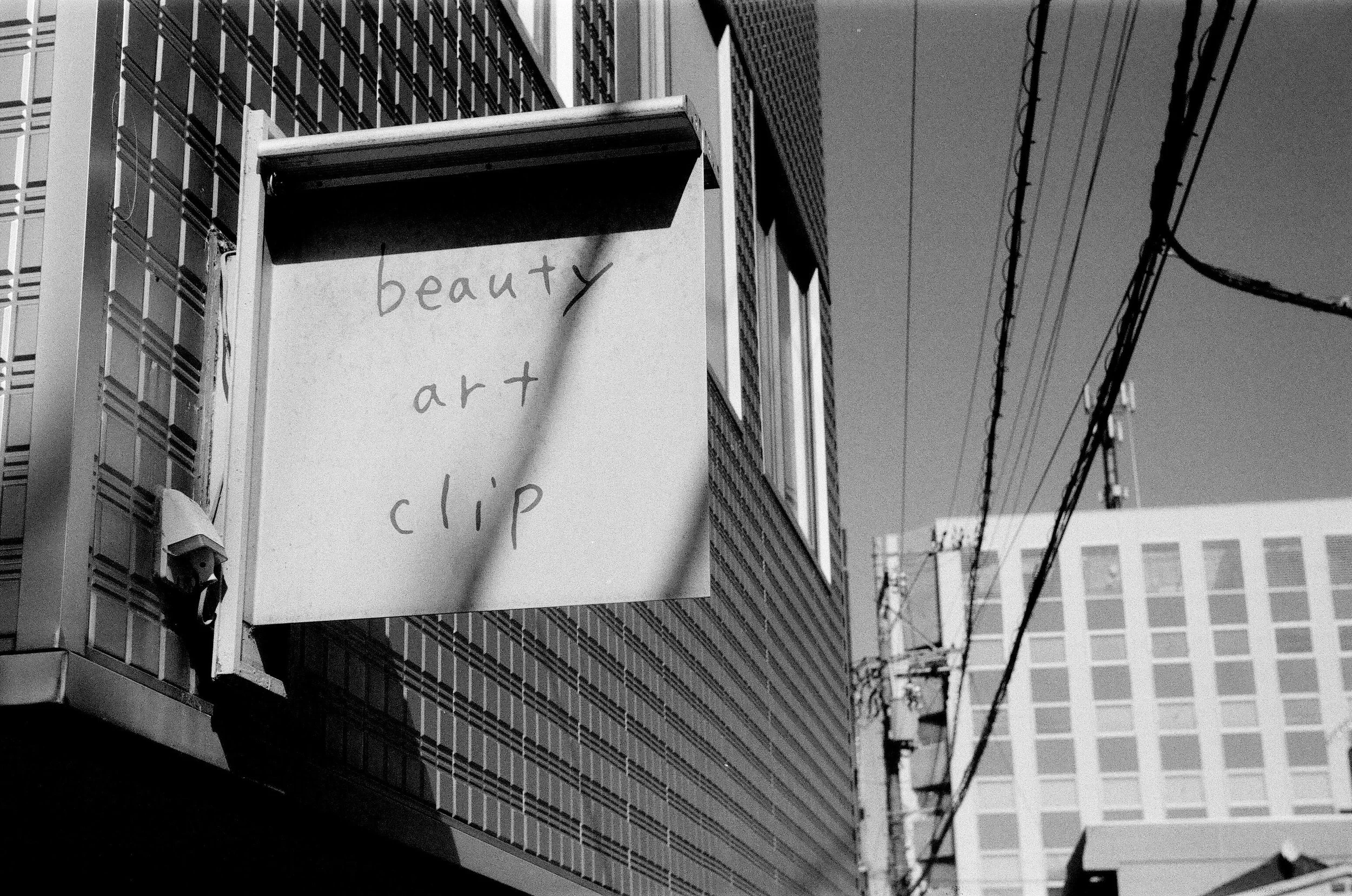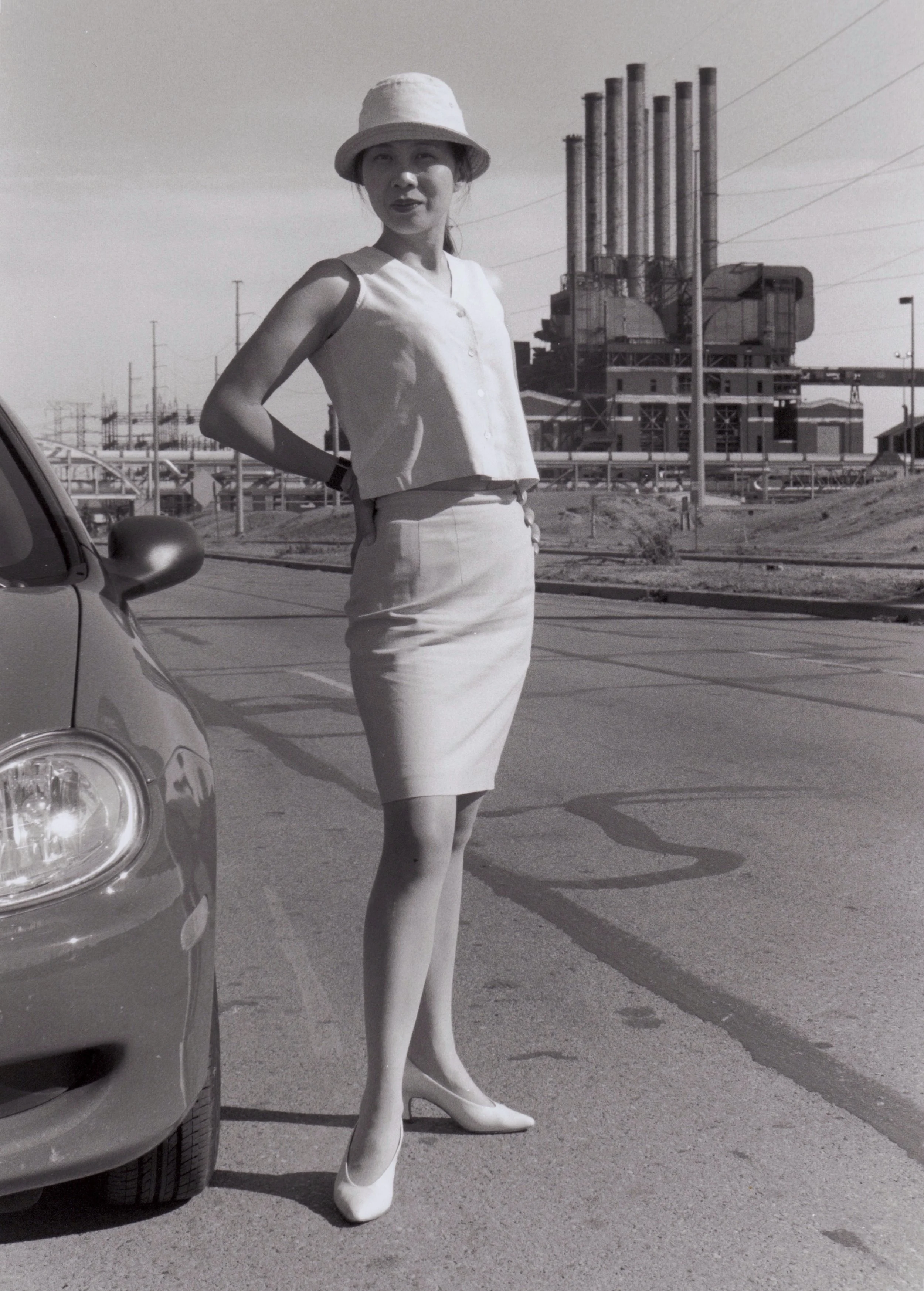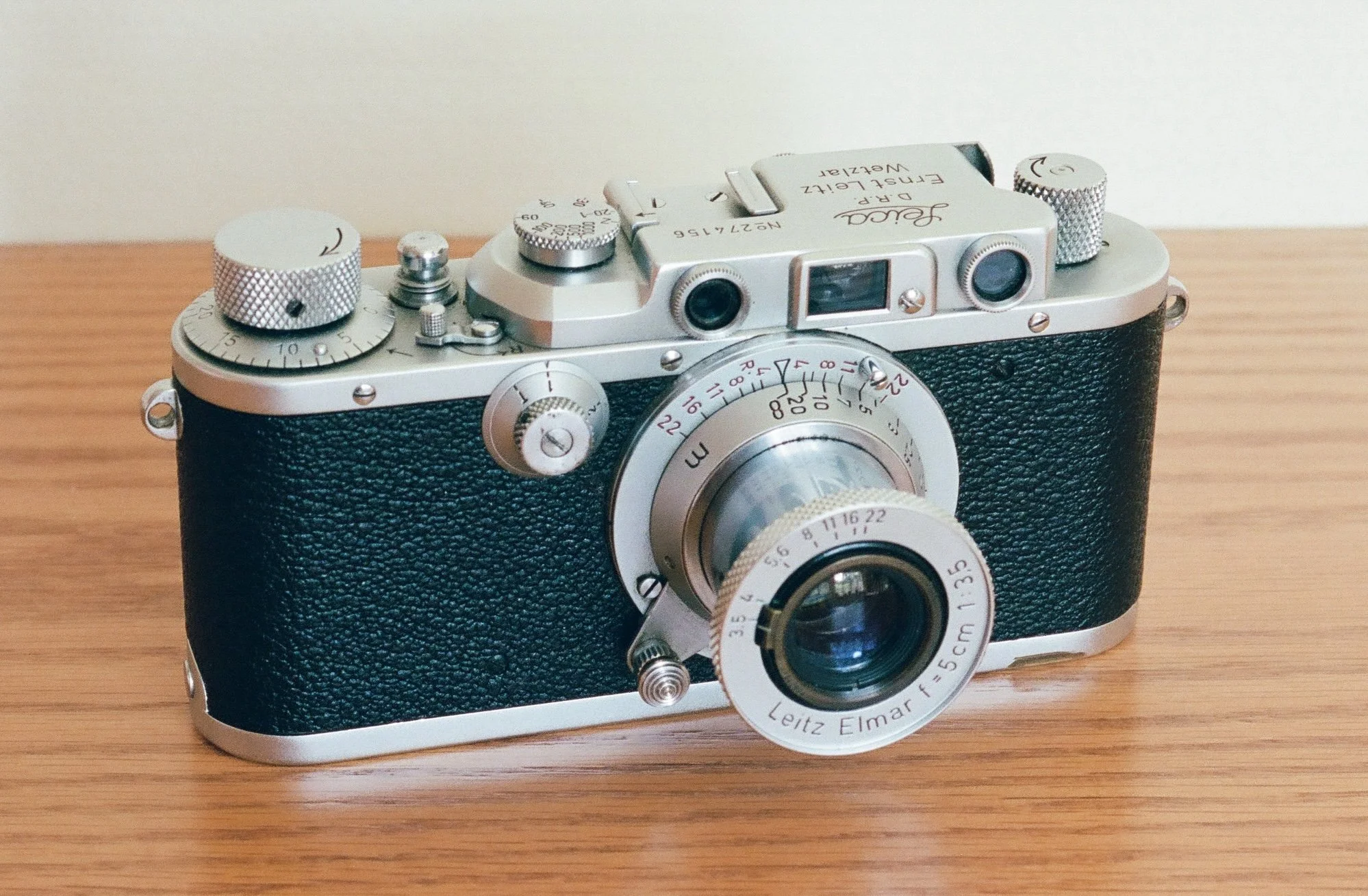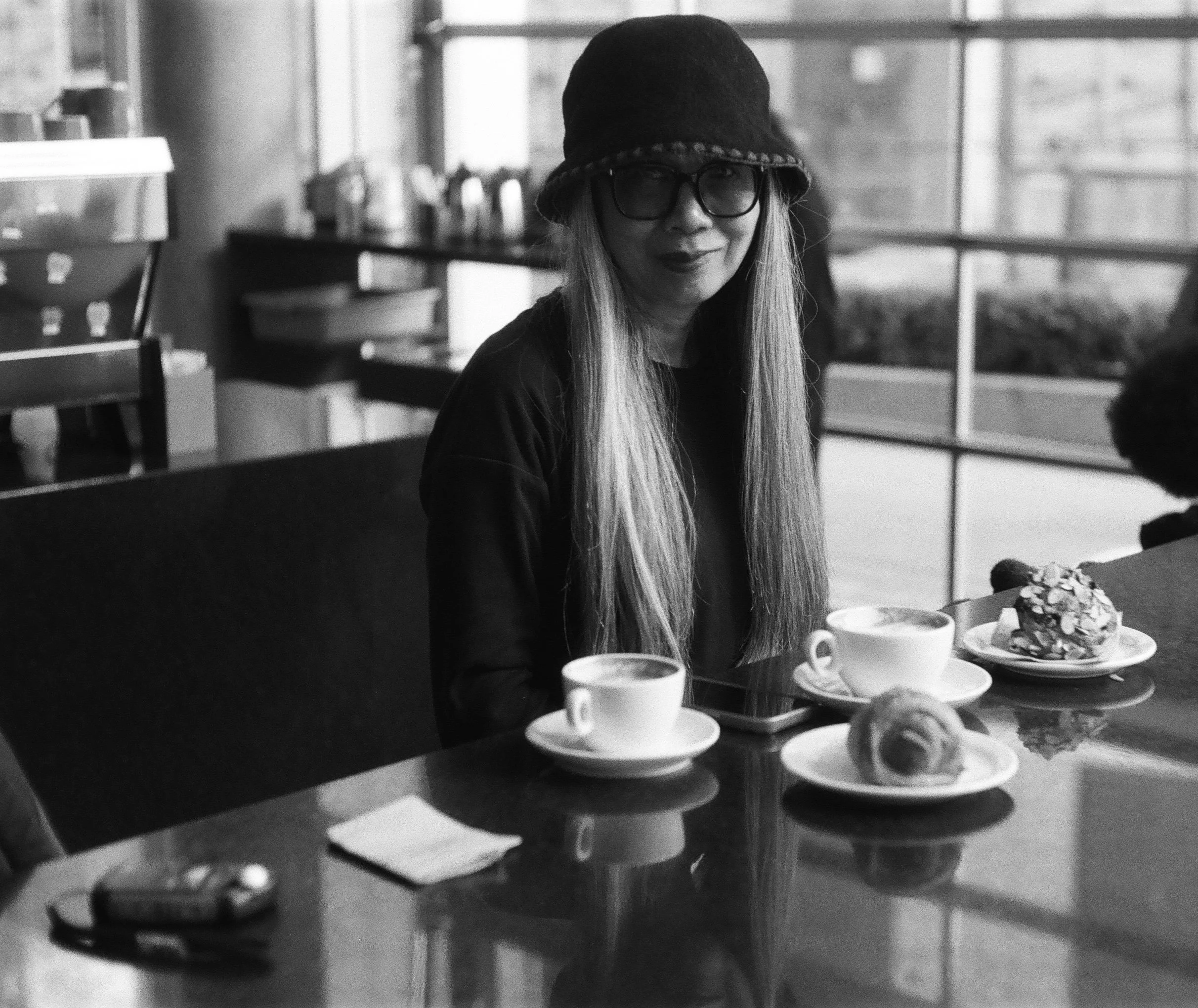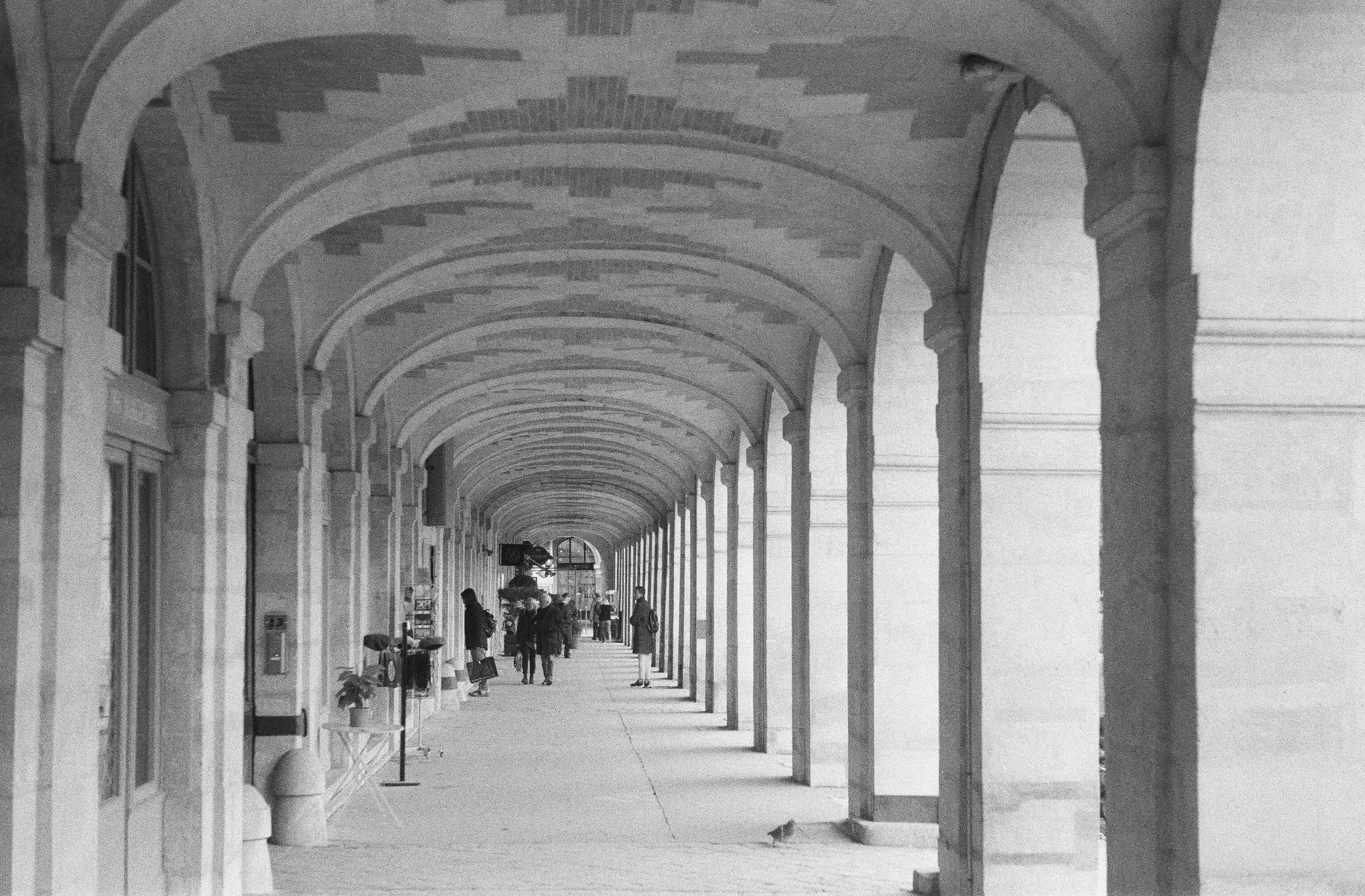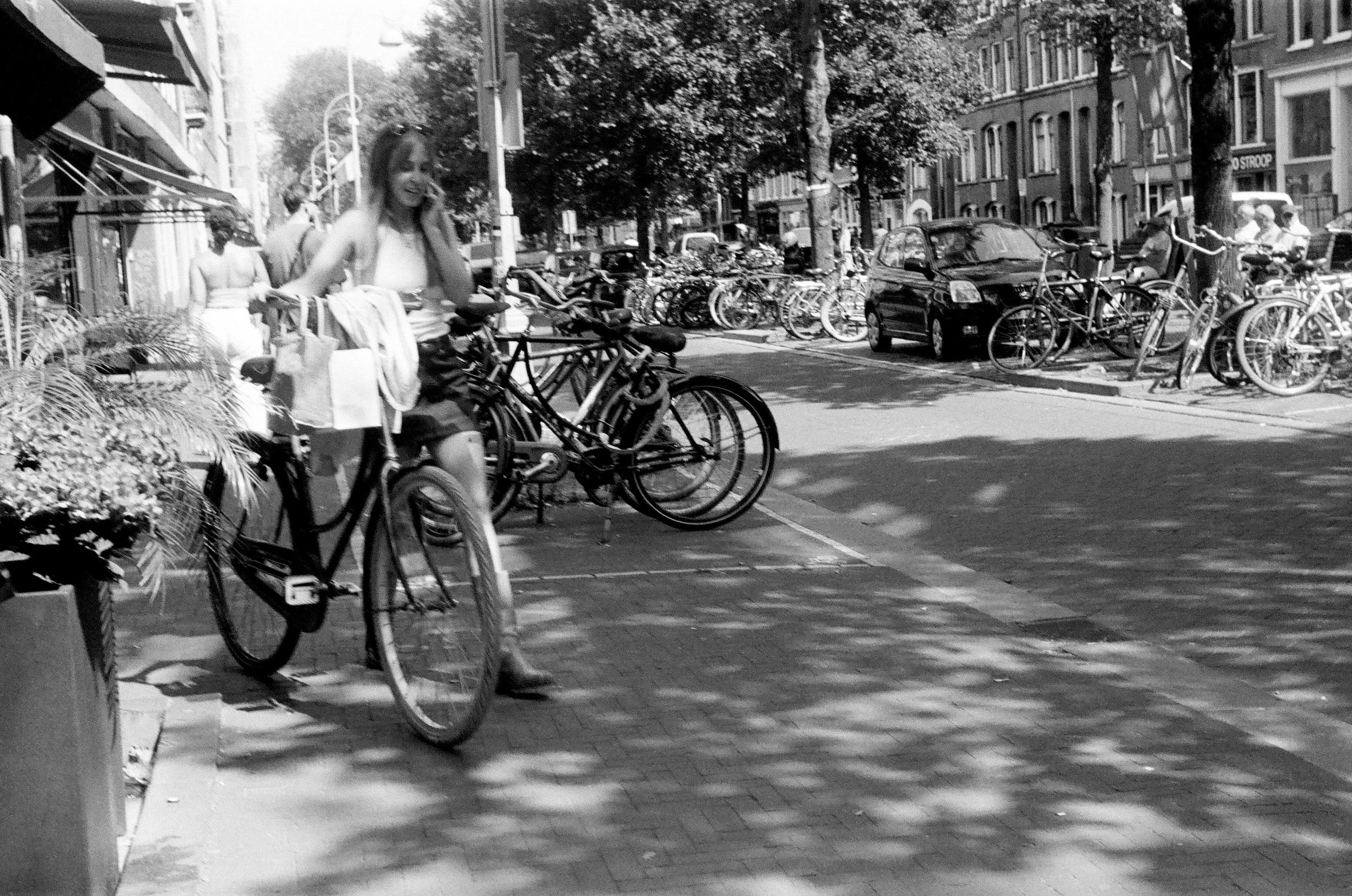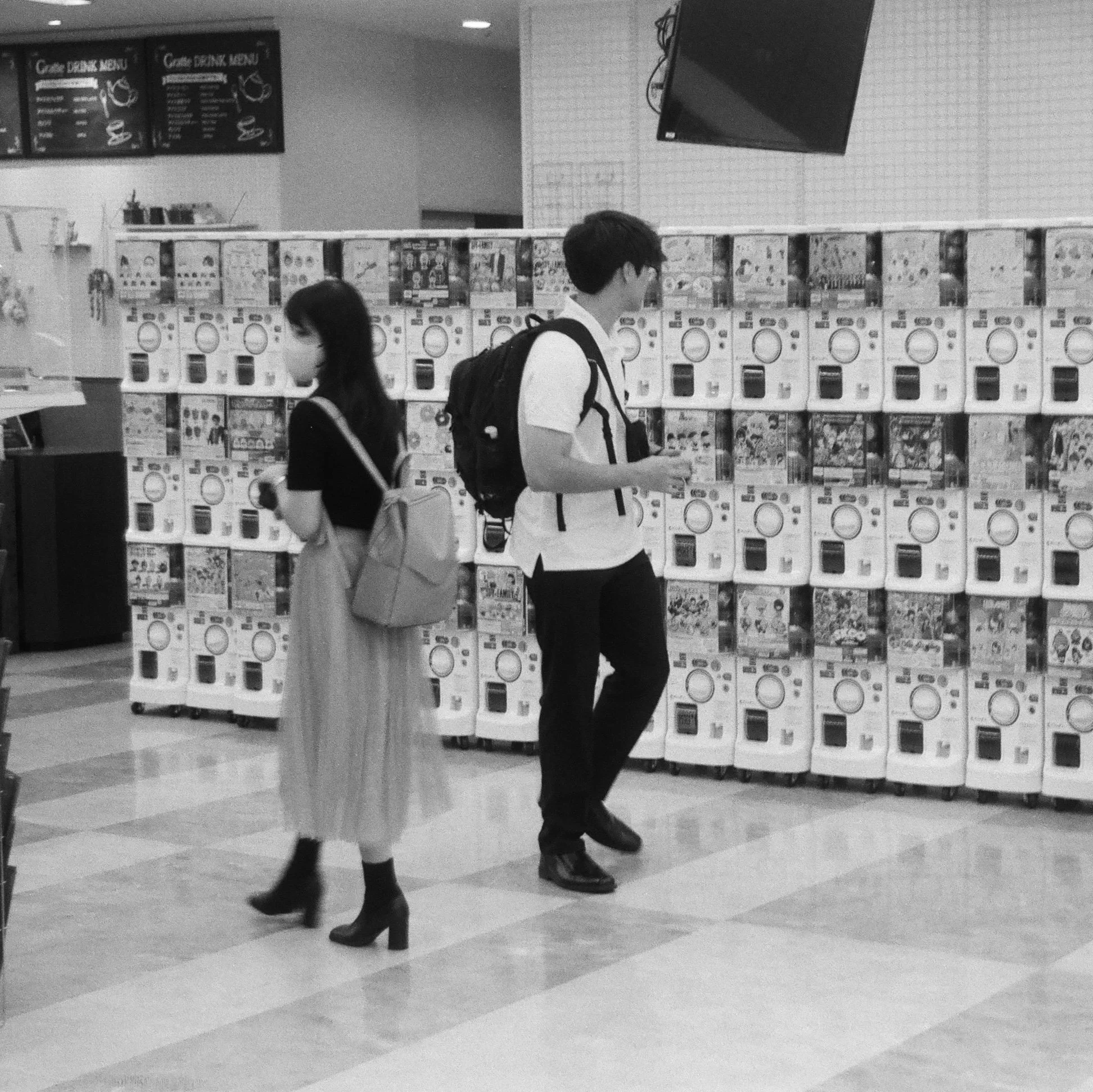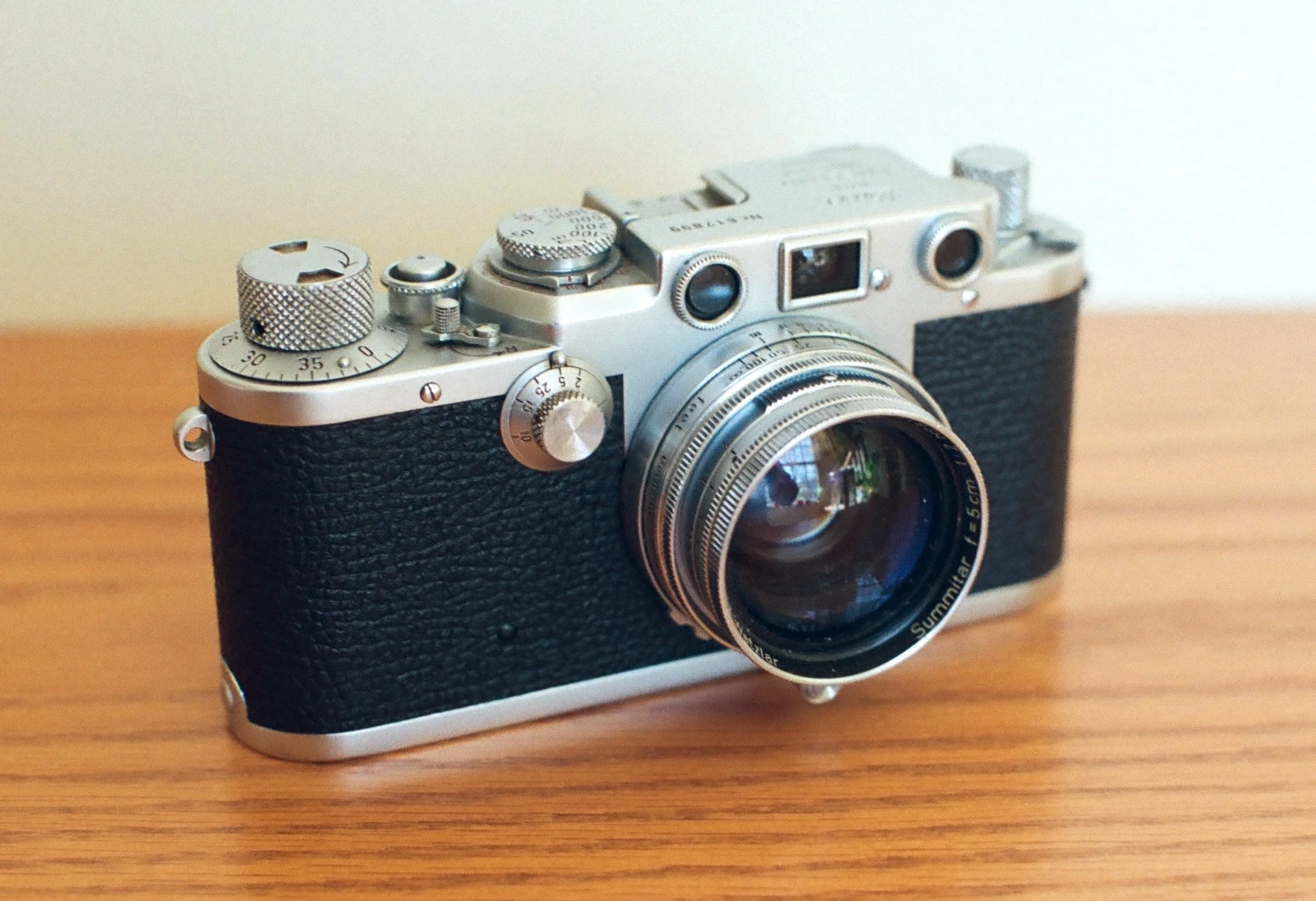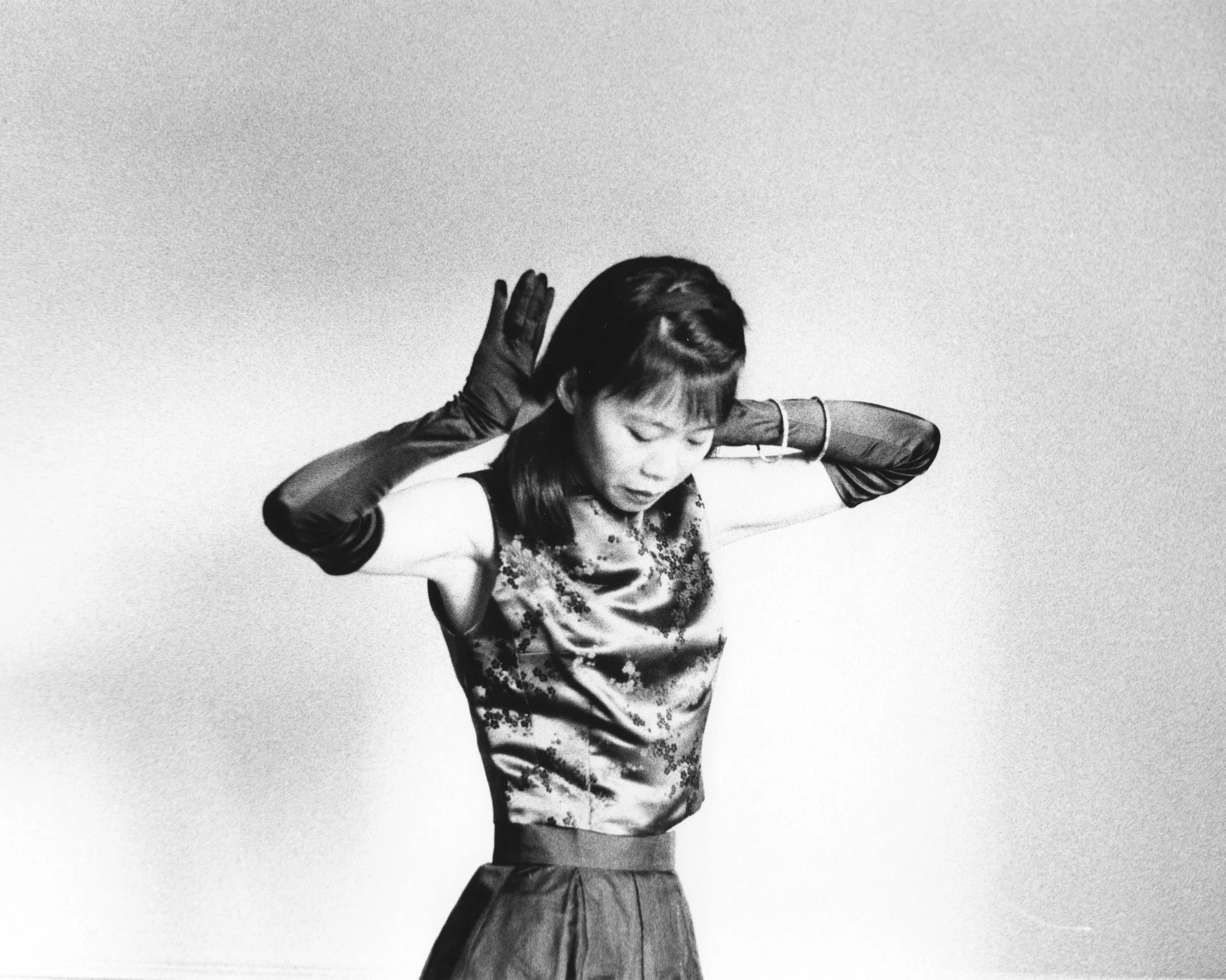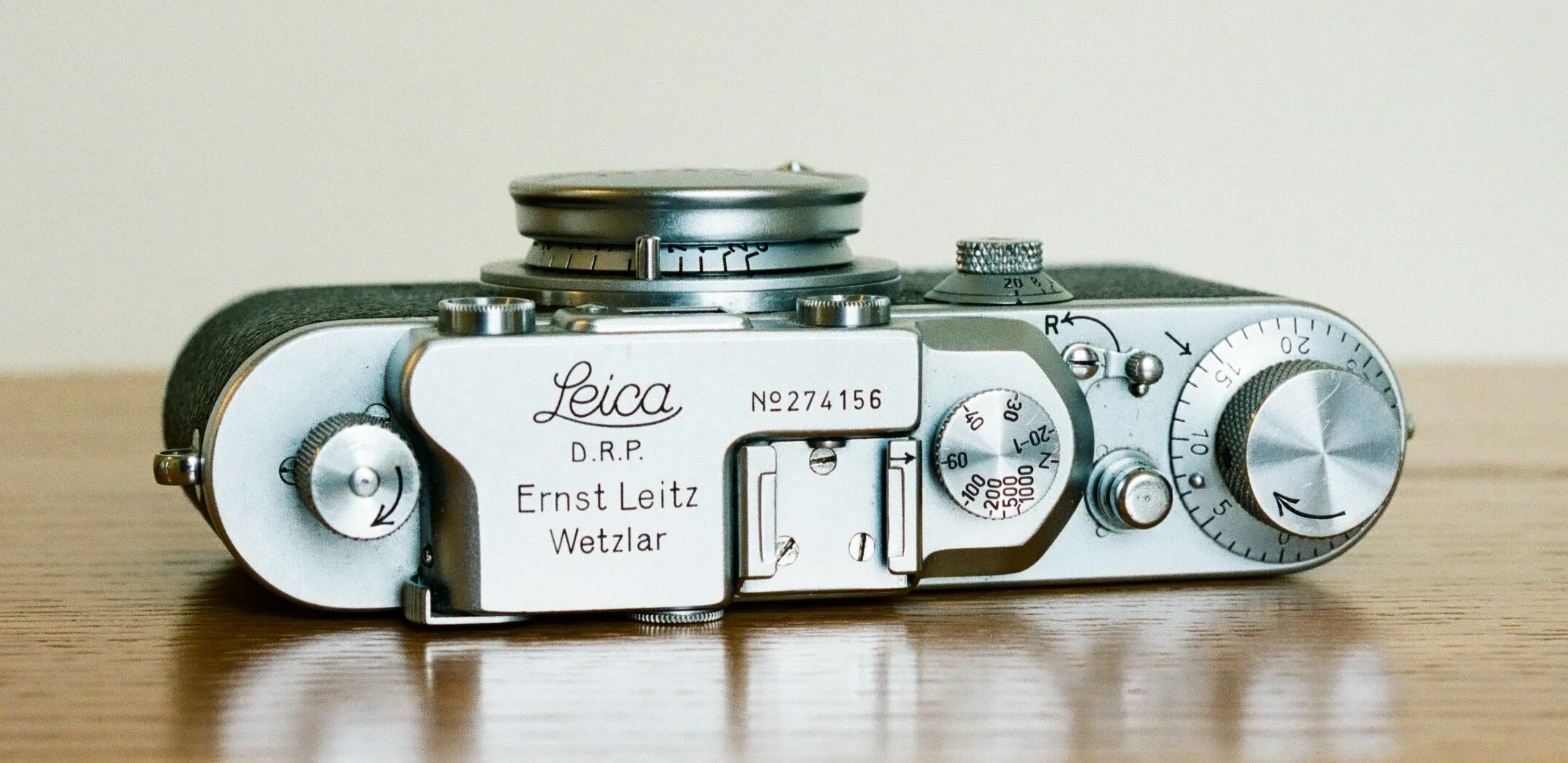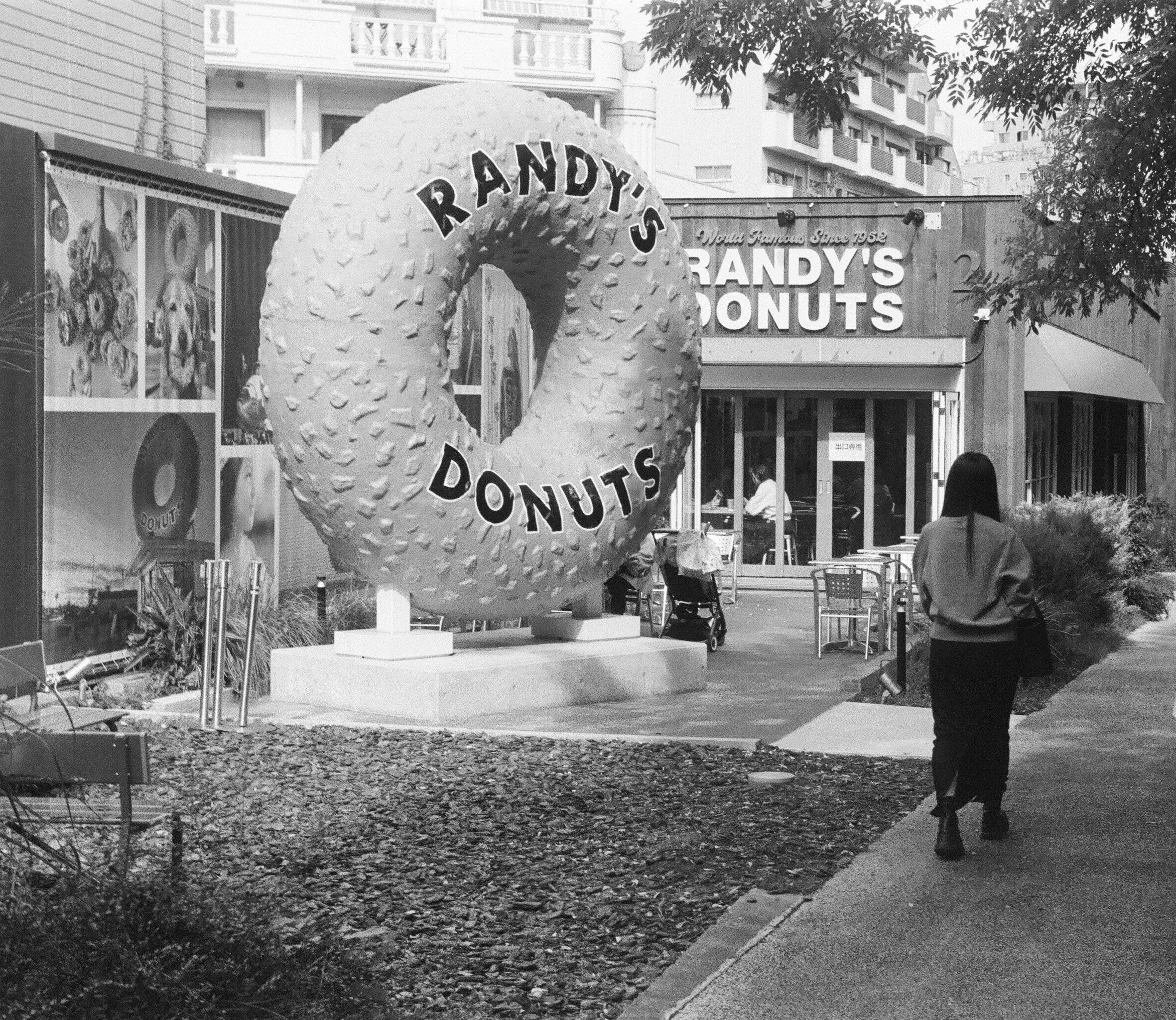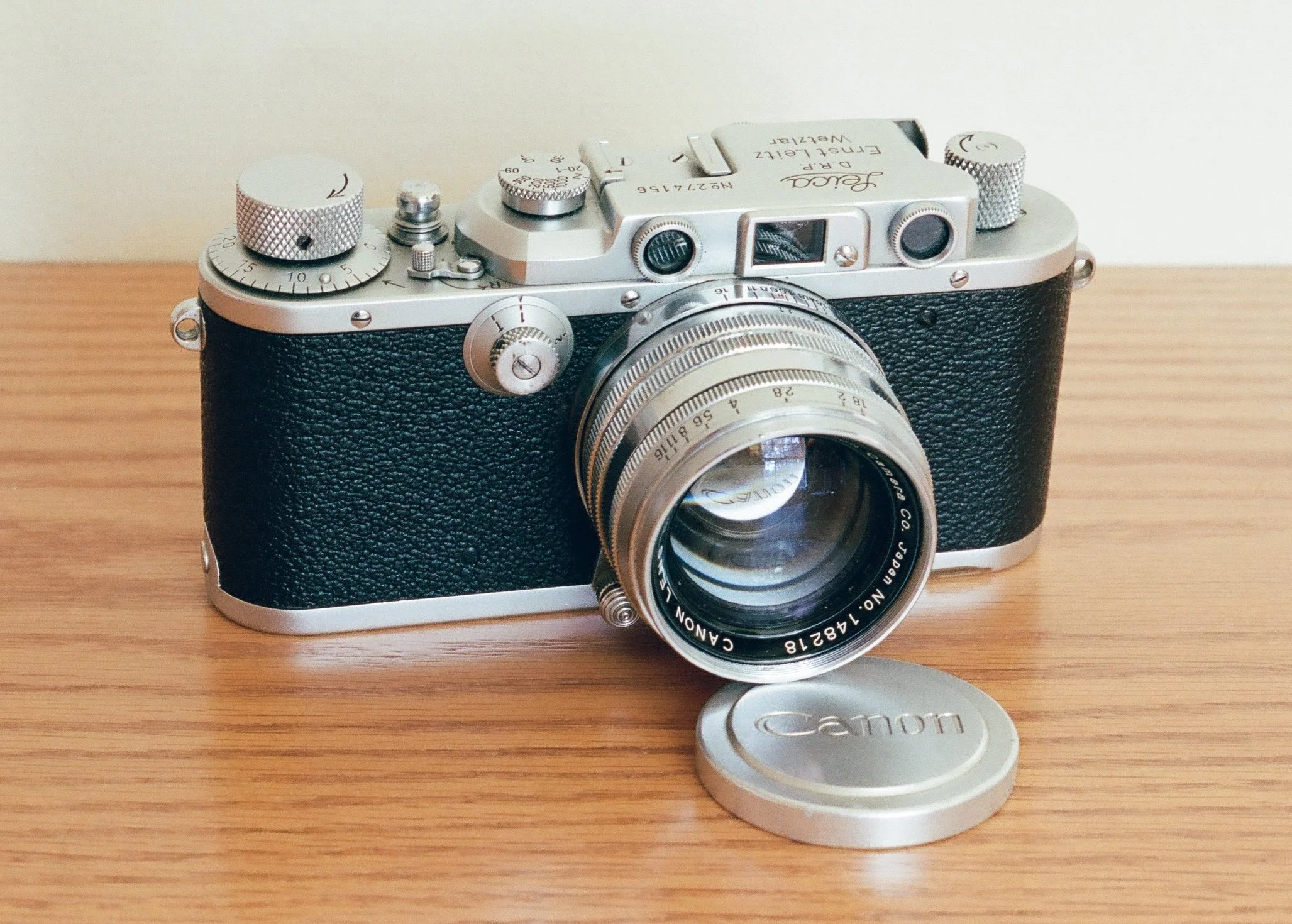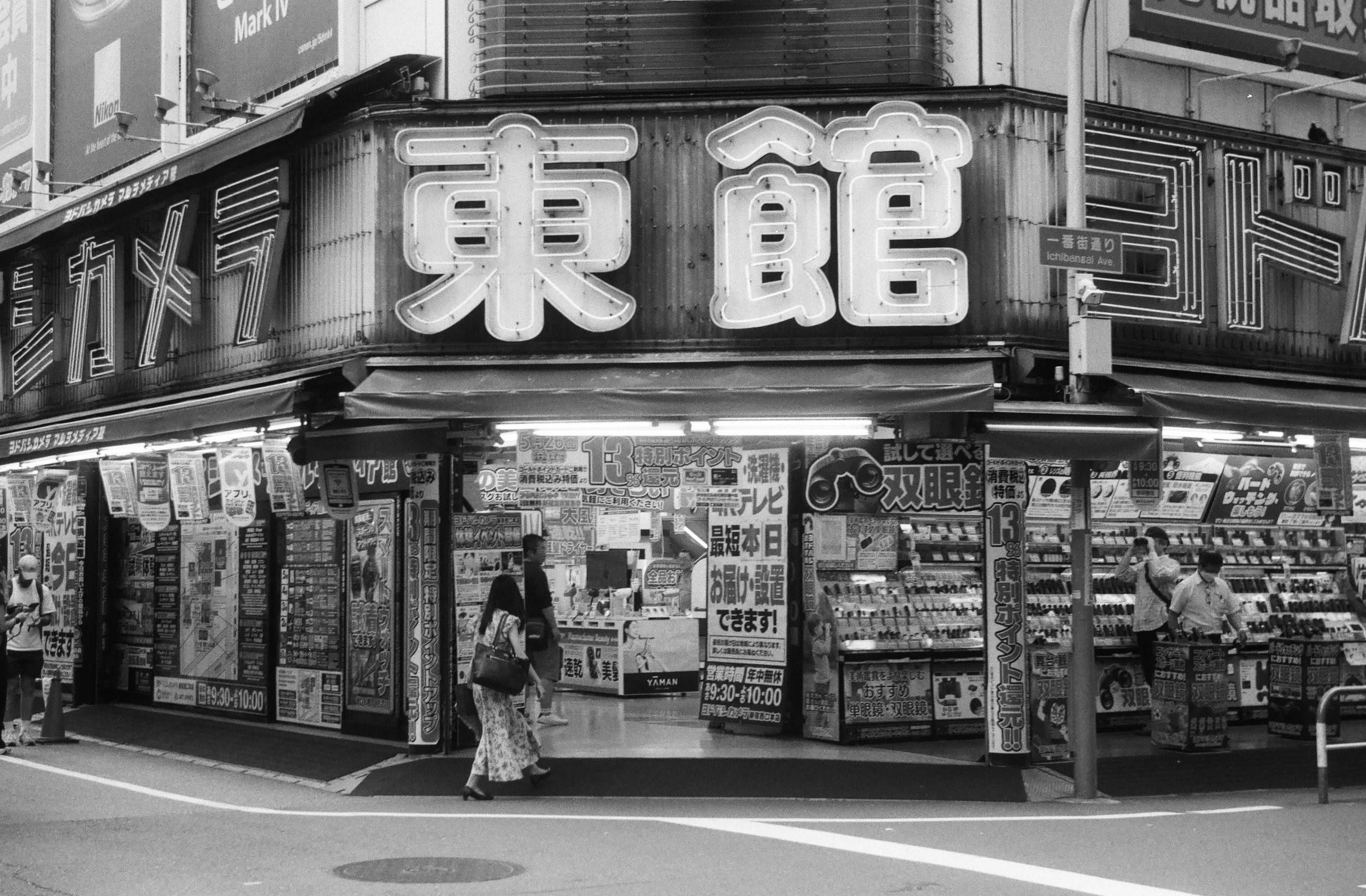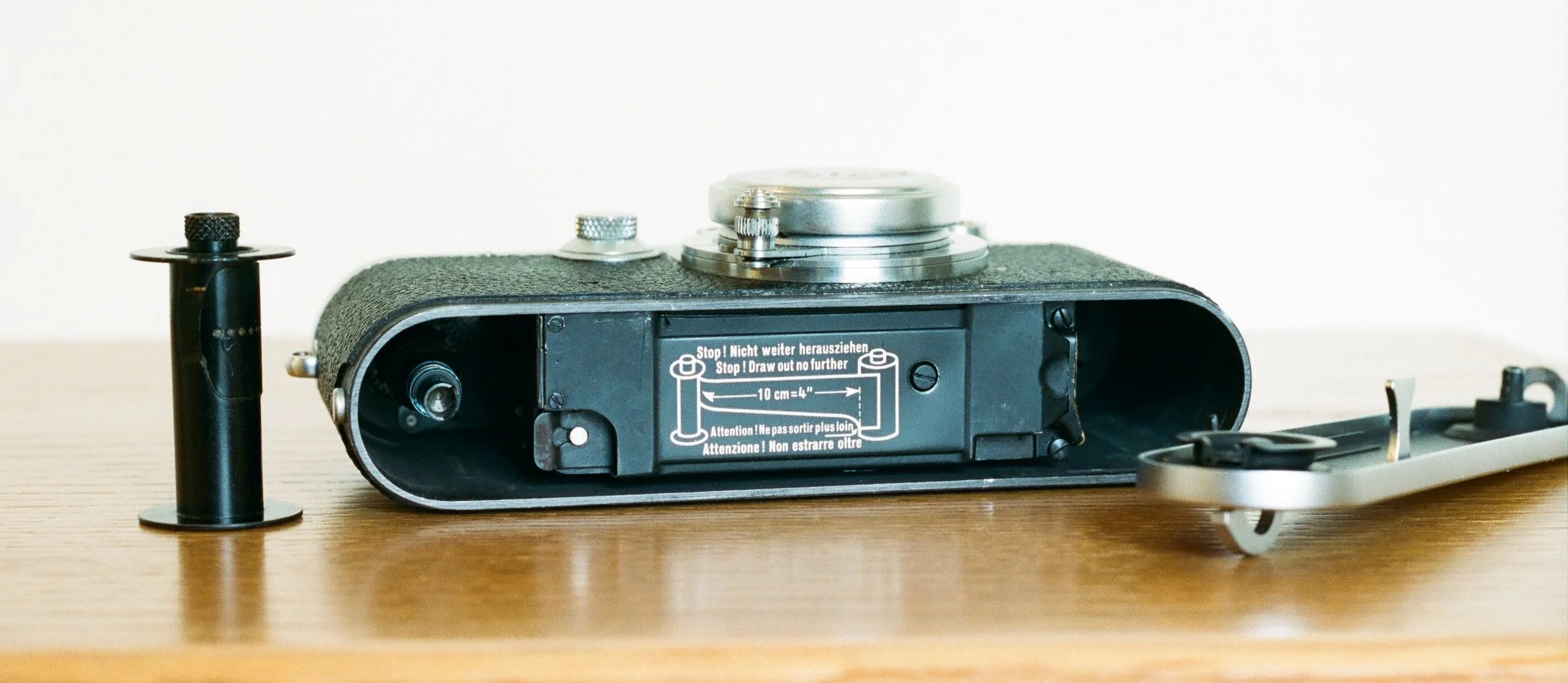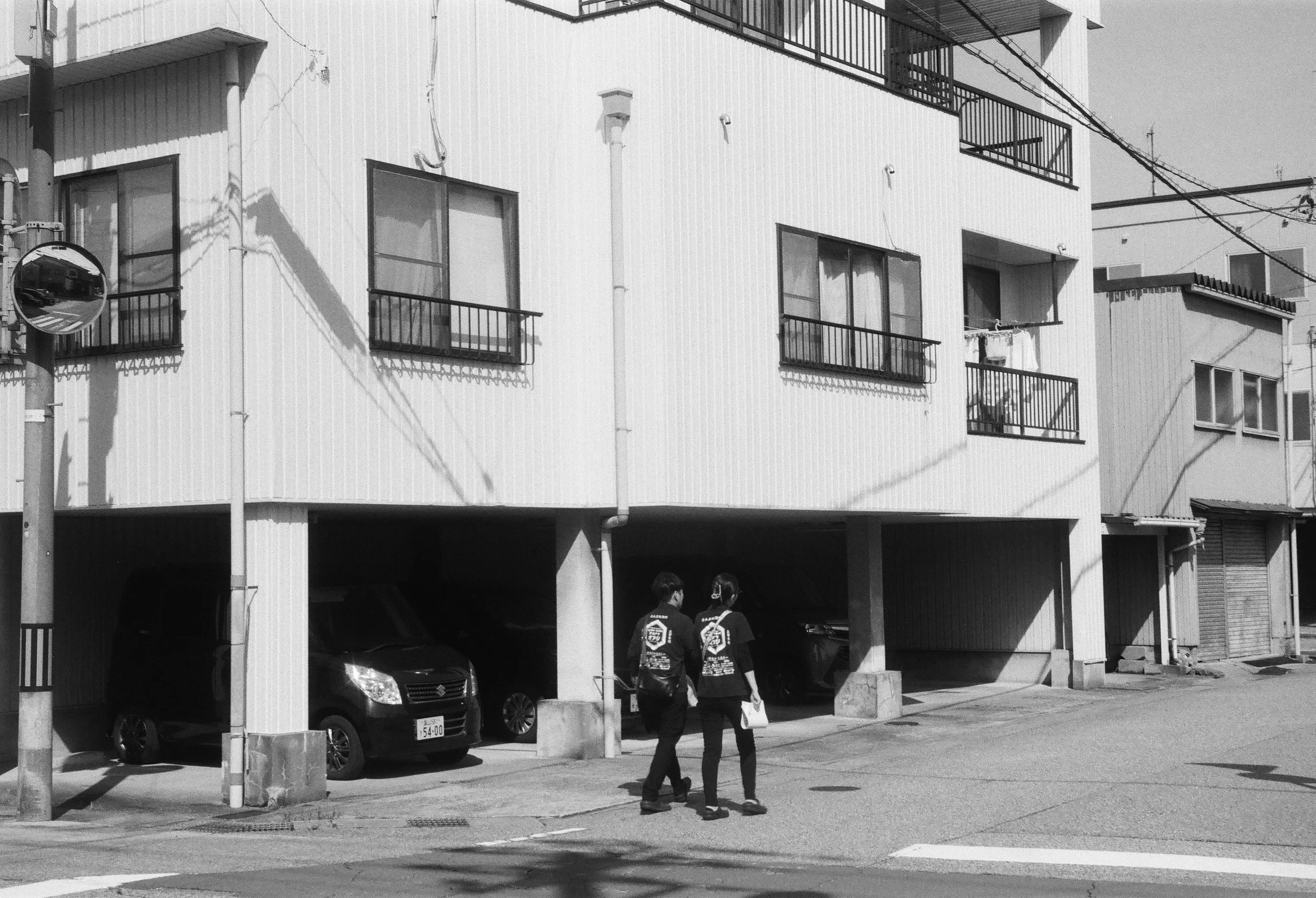Leica (screw mount / Barnack)
The original Leica.
Leica IIf with 5cm f/2 Summitar (Color photos of the cameras were made with a Nikon F, 55mm f/3.5 Micro-Nikkor-P.C, and Portra 400.)
Toyama, Japan Leica IIIc, 5cm f/2 Summitar, Tri-X, 2025.
A landmark design
The screw mount Leica camera is a 20th century industrial design classic. It is literally a work of art — a Leica IIf (the variant shown above) is in the permanent collection of the Museum of Modern Art in New York.
Today (2025), camera manufacturers (including Leica) compete to see who can graft on the most convincing veneer of ‘retro film-type’ styling to their digital cameras. There’s even a ‘List of retro-style digital cameras’ on Wikipedia.
But why settle for a simulation, when you could use the real thing?
Leica IIf with 5cm f/2 Summitar The lens is shown folded.
Dearborn, Michigan Ford Rouge Plant Leica IIIa, 5cm f/3.5 Elmar, Tri-X, early 2000s.
Why are they called ‘screw mount’ or ‘Barnack’ Leicas?
‘Screw mount’ is a reference to the lens attachment mechanism which is a simple and effective 39mm-diameter screw thread design. It was adopted by other camera manufacturers and became known as the Leica thread mount, LTM, or M39.
‘Barnack’ is a tribute to the camera’s designer, Oskar Barnack.
Leica IIIa, 5cm f/3.5 Elmar
Philadelphia Museum of Art Leica IIIc, 5cm f/2 Summitar, CineStill BwXX, 2025.
The origin story
The Leica was created by the Ernst Leitz works in Wetzlar, Germany. The company originated in the 19th century as a microscope maker. In 1913 Oskar Barnack (1879-1936), an engineer at Leitz, built an innovative prototype 35mm camera. Excellent quality photos were made with it, and it later became known as the ‘Ur-Leica’; that is, the very first Leica. Development ceased with the outbreak of the First World War.
Vancouver, B.C. JJ Bean Leica IIIf, 5cm f/2 Nikkor-H.C, Tri-X, 2025
Leica goes into production
Following World War I, Leitz decided to develop a production model based on the Ur-Leica. In 1923 a very small number of pre-production nullserie (0-series) cameras were made. One is in the collection of the Centre Pompidou in Paris.
After making some design mods, the company began production of the Leica I (model A) in 1924 and it was launched onto the market in 1925. It was a fixed lens, scale-focusing camera with a focal plane shutter.
This was ‘the first 35 mm camera to be successfully mass-produced with a 35 mm cinema film format’ (Leica Camera).
There was also a Leica I (model B) of which few were made; it substituted a Compur leaf shutter for the focal plane shutter.
The Leica I (model C) was introduced in 1931 (Rogliatti, 1995:49; some other sources say 1930). It was a model A with the addition of an interchangeable lens mount — the first Barnack-type Leica with the screw mount.
Paris Place des Vosges Leica IIIf, 5cm f/2 Summitar, Tri-X, 2019.
Amsterdam Leica IIIf, 5cm f/2 Summitar, Tri-X, 2024.
Tokyo Leica IIIc, 5cm f/2 Summitar, Tri-X, 2025.
Leica takes off
Closely following the introduction of the Leica I (model C), the 1932 Leica II (model D) added a rangefinder. This established the essential Leica capability set and look. Subsequent models differ in details which are not too significant for my type of work.
1933 was the start of Leica III production. It added slow speeds selected using a dial on the front of the camera. The later Leica II models were essentially Leica IIIs with the slow speed dial deleted and a patch in its place (the camera at the top of this page is an example). The Leica III models have all the capabilities I need and the Leica II models do 95 percent of it.
Ikebukuro, Tokyo Leica IIIf, 5cm f/2 Summitar, FP4+, 2024.
Leica IIIf with 5cm f/2 Summitar
A long production run
Design updates were done through the 1930s, 40s, and 50s. The top shutter speed went from 1/500 to 1/1000, shutter speed intervals were changed, flash synch was added, body structure part-count was reduced, and so on. These variants are described in Matanle (1986) and elsewhere.
Leitz continued to invest in the Leica screw-mount product line even after the introduction of the new bayonet mount M3 in 1954. The last screw-mount Leica was delivered in 1960.
(References for Leica history: Rogliatti 1985, Matanle 1986, Gustavson 2011, Leica Photographic Equipment, Catalog No. 35.)
Washington, D.C. Leica IIIc, 5cm f2 Summitar, Tri-X. 2024.
Imitation is the sincerest form of flattery
Copies of the screw mount Leica were manufactured all over the world. Copying began just two years after the introduction of the Leica II when, in 1934, the FED factory in Ukraine, USSR began mass production of the FED-1. (See the Zarya article for that story).
I have not found a reference to patent licensing; perhaps the Soviet Union in the 1930s was beyond the jurisdiction of the German patent office?
Then, following the Second World War, the Leitz designs appear to have been regarded as open-access in many other countries too. Japanese, Chinese, British, American, and perhaps more screw mount Leica clones hit the market in the post-war era. Examples are in Gustavson 2011, McKeown 1996, and St. Denny 1989.
Bethesda, Md. Leica IIIa, 5cm f/3.5 Elmar, Tri-X, mid-1990s.
These cameras are super-compact
One of the big features of the screw mount Leica is that it is really small. Both the camera body and the lenses are tiny, especially compared to later Japanese SLRs. Rangefinder cameras are intrinsically smaller than SLRs:
Body: no mirror box, plus the screw mount Leica has no rear door (see ‘Film Loading’ below).
Lens: no auto aperture mechanism, and some can fold into the body when not in use (they telescope into the space occupied by the mirror box in an SLR).
A folding lens makes the camera + lens package extra compact as shown below.
Leica IIIa with a 5cm f/3.5 Elmar This lens folds extra flat.
Cambridge, Mass. MIT Stata Center Leica IIf, 5cm f/2 Summitar, Tri-X, 2025.
Viewfinder and rangefinder - Each with its own window
The Leica II and subsequent screw mount Leicas have separate viewing windows for the rangefinder and viewfinder. Some find this inconvenient, but there’s an advantage. Because the rangefinder is not used for framing. it has higher magnification and that helps with focusing.
Pacific Palisades, Calif. Eames House Leica IIIf, 5cm f/2 Summitar, Tri-X, 2024
Daikanyama, Tokyo Leica IIIc, 5cm f/2 Summitar, Tri-X, 2025.
Compatible lenses from other manufacturers
Lately, I’ve been occasionally using Japanese Leica thread mount (LTM) lenses on my Leicas. With Leitz lenses increasingly difficult to find in good condition, high-quality lenses made by others are an attractive option.
Canon made LTM rangefinder cameras and lenses into the 1960s. Nikon’s rangefinder cameras did not use the LTM mount, but the company made LTM Nikkor lenses that were supplied with Nicca cameras.
LTM lenses were made by other Japanese companies such as Chiyoda Kogaku (later renamed Minolta), Tokyo Kogaku, Fujinon, and more. LTM lenses were mass produced in the Soviet Union as well.
Leica IIIa with a 50mm f/1.8 Canon lens
Shinjuku, Tokyo Yodobashi Camera Leica IIIf, 5cm f/2 Summitar, FP4+, 2024.
Camera feel and ergonomics
The controls of screw-mount Leicas, and the way their bottom plates fit, have a smooth, precision-machined feel. They are compact and durable. The main operational downside is that they’re comparatively difficult to frame and focus, and film loading is an involved multi-step process.
Bethesda, Md. Leica IIIa, 5cm f/3.5 Elmar, Tri-X, mid-1990s.
St. Louis, Mo. Missouri Botanical Garden Leica IIIf, 5cm f/2 Summitar, FP4+, 2024.
Film loading
It’s not done the usual way. There is no rear door, nor does the back of the camera come off. Access is only from the bottom. Here’s the general idea:
Remove the bottom of the camera. There’s a drawing inside, showing how the film leader is to be trimmed. Leica made a template, but it’s not necessary and I don’t have one. I use a pair of scissors and follow the drawing.
Remove the take-up spool and insert the trimmed film leader.
Insert the film canister + film leader + take-up spool assembly into the camera, upward from the bottom.
Put the camera bottom back in place, and wind the film on, while checking the rewind knob to make sure that the film leader is properly attached to the take-up spool.
Manually reset the film frame counter.
There is a detailed, illustrated, step-by-step set of instructions for this in Emanual (1957). It’s a finicky process but after a few rolls of film it becomes second nature.
Leica IIIf ready for film loading.
Loading from the bottom does have advantages:
Lack of a door or removable back makes the camera body stronger. No camera I’ve used, not even the Leica M3, has the solidity of a screw-mount Leica.
The bottom plate attaches to the body with a precise metal-to-metal fit. No need for the foam light seals used in the film doors of many 35mm cameras.
Kanazawa, Japan Leica IIIf, 5cm f/2 Summitar, FP4+, 2024.
The screw mount Leica in use
Screw mount Leicas are among my top favorite cameras. They are small, have an unmatched smooth and precise feel, and some of the greatest photographs of the 20th century were made with them.
A disadvantage of the compact design is that the rangefinder and viewfinder are small, so composition and focus are not as quick and accurate as with, say, an M-series Leica or a Japanese SLR. Also, film advance and film loading/unloading are not so quick. And, these are very old cameras that may require servicing (see below).
Glen Echo, Md. Glen Echo Park Leica IIIf, 5cm f/2 Summitar, Tri-X, 2025.
Maintenance and repair
The shutter curtains of my Leica IIIa were replaced in the late 1990s by Penn Camera Exchange, a Washington, D.C. camera shop that is no longer in business.
YYe Camera in Canton, Mass. recently gave my Leica IIIc a thorough overhaul. That included a new rangefinder beam splitter which improved rangefinder visibility quite a lot. https://www.yyecamera.com
Toyama, Japan Leica IIIf, 5cm f/2 Summitar, FP4+, 2024.
References / further reading
Camera manual: orphancameras.com
More references:
Cartier-Bresson, H. 1999. The Mind’s Eye: Writings on Photography and Photographers. New York: Aperture. Writings by the master of the ‘decisive moment’.
Cartier-Bresson, H. 1976. Henri Cartier-Bresson. New York: Aperture Foundation. Masters of Photography series. 95 pages of photography and text by Cartier-Bresson.
Centre Pompidou, Paris. The collection includes a pre-production 0-series Leica from 1923. https://www.centrepompidou.fr/en/ressources/oeuvre/c4b9dzK accessed Aug. 31, 2025.
Emanuel, W.D. 1957. Leica Guide: How to Work With All Leica Models From I to M3. New York: American Photographic Book Publishing Co., Inc.
Film loading is explained step-by-step, with illustrations, on pp. 13-15.
Gustavson, T. 2011. 500 Cameras: 170 Years of Photographic Innovation. New York: Fall River Press. The 500 cameras are from the George Eastman House Technology Collection, Rochester, N.Y. Multiple screw mount Leicas and Leica copies are described..
Instructions for Models — Standard, IIIa & 250 and Accessories.. n.d. Ernst Leitz, Wetzlar and London. Hove Camera Company reprint, Hove, Sussex, England. n.d.
Leica Camera. From Vision to Legend: The History of the Leica I. https://leica-camera.com/en-US/photography/100-years/the-history-of-the-leica-I accessed Oct. 7, 2025.
Leica Photographic Equipment, Catalog No. 35. 1960. E. New York: Leitz Inc.
List of retro-style digital cameras. n.d. https://en.wikipedia.org/wiki/List_of_retro-style_digital_cameras accessed Nov. 5, 2025.
‘These cameras are designed to resemble and are often mistaken for vintage film cameras’.
McKeown, J.M. and J.C. 1996. McKeown’s Price Guide to Antique and Classic Cameras, 1997-1998. Grantsburg, Wis.: Centennial Photo.
Has 14 pages on Leitz/Leica cameras and lenses, including a tabular guide to identification of the different models (p. 292) and a list of Leica serial numbers (pp. 293-297).
Matanle, I. 1986. Collecting and Using Classic Cameras. London: Thames and Hudson.
Morgan, W.D. and H.M. Lester. 1956. Leica Manual and Data Book. New York: Morgan & Morgan.
Museum of Modern Art, New York. The collection includes a Leica IIf. Architecture and Design Department, Object number 1271.2018.a-c https://www.moma.org/collection/works/292758 accessed Aug. 31, 2025.
National Museum of American History, Smithsonian Institution. The collection includes a Leica I (model C). https://americanhistory.si.edu/collections/object/nmah_1145349 accessed Aug. 31, 2025.
Pritchard, M. 2015. A History of Photography in 50 Cameras. Buffalo, N.Y.: Firefly Books. The Leica I is camera no. 20.
Rogliatti, G. 1985. Leica: The First 70 Years. East Sussex, England: Hove.
St. Denny, D. 1989. Cameras of the People’s Republic of China. Leicester, England: Jessop Specialist Publishing.
pp. 75-78: The Shanghai Camera Factory made screw mount Leica copies from 1958 to 1963.
Heddon-on-the-Wall, England Leica IIIf, 5cm f/2 Summitar, FP4+, 2024.

